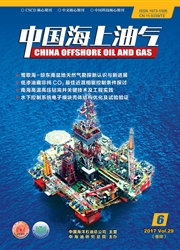

 中文摘要:
中文摘要:
基于钻柱与钻井液耦合影响因素分析,建立了钻柱失效模型,利用流固耦合和钻柱振动的基本理论对钻柱的振动频率和振动速度进行了求解,分析了钻井液密度、流速、流动应力以及钻柱的振动频率和速度对钻柱失效的影响,在此基础上利用冲蚀理论对钻柱的失效进行研究得到了钻井液对钻柱的冲蚀磨损量以及最大冲蚀角度。根据算例参数设计了对应的室内实验,并将算例分析结果与实验结果进行对比,验证了本文所建的钻柱失效模型的正确性,结果表明考虑流固耦合钻井液对钻柱的冲蚀磨损量要远大于未考虑流固耦合钻井液对钻柱的冲蚀磨损量;层流状态下钻井液引起钻柱失效所发生的最大冲蚀角与钻井液和钻柱之间是否进行流固耦合无关。工程应用实例表明,本文研究结果可以较好地指导钻井作业实践,对于减少钻柱失效和降低钻井成本具有一定的参考意义。
 英文摘要:
英文摘要:
On the basis of the analysis of the influencing factors in the fluid / structure interaction,a model of drillstring failure was established. By solving the equations based on the fluid / structure interaction and drillstring vibration theories,the vibration frequency and velocity of drillstring were obtained,and effects of the fluid density,flow rate,flow stress,and the vibration frequency and velocity of the drillstring on the drillstring failure were analyzed. Moreover,the drillstring failure phenomenon was studied using erosion theory,resulting in the erosion masses and the maximum erosion angle. The corresponding laboratory experiment was designed according to the factors of numerical examples. The comparison between analysis results of numerical examples and the experimental results proves the model established in this paper to be correct. The results show that the erosion masses of drillstring considering the fluid / structure interaction are much greater than that without considering the interaction; under laminar flow,the maximum erosion angle had the same value whether the fluid / structure interaction was considered or not. Field application cases show that the conclusions of this study can guide the drilling operation and have certain theoretical reference significance for reducing the drillstring failure and lowering the cost of well drilling.
 同期刊论文项目
同期刊论文项目
 同项目期刊论文
同项目期刊论文
 Contrast study on the radial velocity of the flow field of the hydrocyclones with different inlet st
Contrast study on the radial velocity of the flow field of the hydrocyclones with different inlet st 期刊信息
期刊信息
